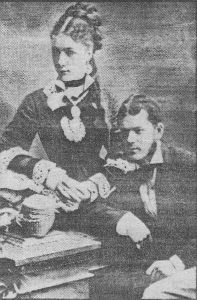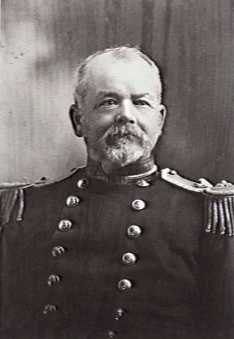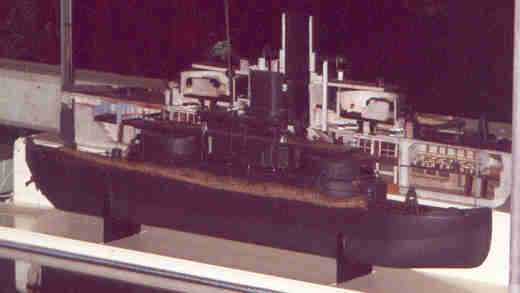| James (Jim) Lenox Breaks
Fleet Engineer
By Shirley M. Joy.
|

James & his wife Alice Jobson
|

James Breaks from the AWM website ID 305329
|

James Breaks in 1900
The Weekly Times July 14 1900.
courtesy of "Newspaper Collection,
State Library of Victoria"
|
The name “James Breaks” is synonymous with the name HMVS Cerberus, as James, aged 22 years, sailed from England on the Cerberus on her maiden voyage, and was associated with the ship for 34 years until he retired.
James, one of the three junior engineers, kept a log on the voyage of the Cerberus to Australia in 1870 – 1871. As far as is known it is the only surviving personal log of the trip and is held by Mr. Peter Williams of the Maritime Trust.
The Melbourne newspaper The Herald on 26th. December, 1972 carried extracts from James Breaks’s log and they are repeated here as they graphically convey to the reader some of the hardships endured by the officers and crew of the Cerberus on her 153-day maiden voyage from England.
“It is not surprising to read what James Breaks wrote in his log at Chatham Dockyard six weeks before they sailed : “Working on the engines. Life insurance agents down by the score”. And four days later : “Cleaning up boilers. Life insurance agents on to me again.”
The first note of unease creeps into the log on October 31 when Cerberus hove to off Spithead en route to Plymouth : “Blowing a gale, too rough to proceed under banked fires. Big timber ship went down in night off us on Mother bank ….”.
On November 4, three days before they left Plymouth for Melbourne, Breaks wrote : “….men joined ship from London. A rough lot.” On the eve of departure 28 men were absent without leave.
TUMBLING. On November 7 at 10.30 a.m. Cerberus steamed out of Plymouth – Melbourne bound. Two days later Breaks wrote : “Everything working well. Tumbling about a good deal. Everybody anxious, do not know what she would be like in a seaway.” Next day was bad too. “High sea, ship rolling a great deal. Sick”. But overnight the young engineer’s stomach improved if not the weather. “Ship rolling very much. Better”.
At Malta on November 27 Breaks went ashore. Next day came tragedy : “Nearly all hands on shore, broke ship ….boat coming off to ship full of men upset. Shannon drowned, a good man”. The following day, November 29, Breaks went to the opera on Malta with one of the first engineers, Brodie : “Men still on shore breaking leave. Had guard boat rowing round us day and night, great trouble with men and Mr. Spring”. (Spring was one of three junior engineers).
Next day 10 men were sent to jail ashore. Cerberus reached Port Said on December 19. Next day a sister ship the Abyssinia arrived en route to Bombay. On December 21 Cerberus, under tow, began the passage through the Suez Canal. That night she anchored after about 40 miles : “Had a good look at the scenery, all sand. Abreast of the village of (indecipherable) …. Was kept awake all night through howling of Arab dogs.
In getting away first the Cerberus can claim to be the first iron clad to pass through the canal ….”. On Christmas day 1870, Cerberus left Suez and headed into the Red Sea : “Took on board Arab pilot. A fine big handsome man lived on upper deck. Did all his own cooking”.
The heat was hell. There were other biblical reminders too. December 26 : “…. Passed Mt. Sinai, snow capped”. Despite the heat Breaks had “a very bad cold,” But “those who had a New Year’s Day hangover must have suffered abominably”. Breaks says that on January 1, 1871, engine room temperature reached 125 deg. Fahrenheit, and in the stokehold 141. Two days later he wrote : “…. Can hardly breathe below ….cannot keep steam, 128 deg. in engine room, 142 in stoke-hold”.
Cerberus anchored off sun-seared Aden on January 6. Breaks thought it “a black looking place”. On January 8 he drove out to the great water tanks cut from solid rock in ancient times (by the Queen of Sheba?) and remarked, “ ….the sale-yards of camels and the native town are very curious places.” Next day : “Very hot, not a breath of wind. Ship full of natives selling feathers, etc”.
In the Indian Ocean one day out from Point des Galets on Reunion Island, the heat was still intolerable : “ ….cannot get a sleep. Ventilation engines not working to save coal. Can hardly breathe. Paint work in cabin turning brown ….”. Five days later, more trouble – this time involving another junior engineer : “Smith had his fingers crushed in port engine”.
HURRICANE. Cerberus reached Batavia on February 17 and sailed on January 25. Two days later Breaks had a few alarming moments : “Blowing a hurricane. Had a narrow escape ….they thought I had been washed overboard or crushed by the spare topmast breaking away from the lashings. I was sent to replace a bunker cover the sea had washed away. The sea was pouring down below. It was a very long time before I could get back to the hatch-way, had to cling to top of turret”.
And next day : “Blowing a gale, very high sea. Ship unmanageable, rolling, everybody in state as to safety of ship. Washed 70 to 80 tons of coal off the deck. Had to rig lifelines in the stokehold”. March 15 Cerberus sighted the Australian coast. Three days later while she was replacing the lost coal in Fremantle the West Australian governor, Governor Weld came aboard. Breaks and Smith (his hand still in a sling) went ashore to church in Albany when Cerberus anchored in King George Sound : “Walked up hill forgetting about no twilight, had a trouble to get back to hotel. Saw first native man and women”.
On April 2 Breaks wrote : “Fine day, birthday, steaming towards Melbourne”. A week later they were there.”
Note : The Geelong Advertiser, Saturday, April 22nd. 1871 carried the “Official Report of Lieut. Panter. H.M.V.S. Cerberus, Hobson’s Bay, 10th. April, 1871,” in which Lieut. Panter recorded – “ …… This I had done at Plymouth, and after coaling and getting some more men I sailed on the 7th. November for Gibraltar.” This confirms that the voyage of H.M.V.S. Cerberus from Plymouth to Melbourne, took 153 days.
JAMES LENOX BREAKS IN WILLIAMSTOWN, VICTORIA.
James Breaks and the members of the crew enjoyed a heroes’ welcome when the Cerberus moored in Hobson’s Bay, Melbourne, on April 9, 1871. James may not have realized it at the time, but he had arrived at his destination which, for the next 48 years of his life, was to be his “Home Port.” He rose from junior engineer to the top post of Fleet Engineer of the Victorian Navy, and retired from the newly formed Commonwealth Naval Forces in 1905 with the same rank.
James Breaks was born c.1848 in Portsmouth, England to James Breaks – Foreman, Her Majesty’s Dock Yard, Chatham, and his wife Elizabeth Breaks, née Anchor. On the 23rd. May, 1876 James Breaks married Alice Jobson, aged 20 years, at Holy Trinity Church of England at Williamstown, Victoria. Alice, born at St. John’s Westminster, England was the daughter of John Jobson, Builder and his wife Emma Jobson, née Falkner.
James and Alice Breaks had two daughters – Louise Amy born at Williamstown in 1877 and Alice Maud born at Williamstown in 1879.
On the 6th. February, 1919, James Lenox Breaks, “Engineer Commander R.A.N.”, died at 34 The Strand, Williamstown from Chronic nephritis and Cardiac failure. James, aged 70 years at the time of his death, was buried in the Williamstown Cemetery.
Grave Reference - Church of England “N”, Row 21.5, Grave 6.
Appointed 1st Assistant Engineer on the resignation of Thomas Bennet.
Williamstown Chronicle, 22 June 1878
Appointed Chief Engineer
Victorian Government Gazette, 31 August 1888
Appointed Fleet Engineer
Victorian Government Gazette, 29 November 1889

Cutaway model of Cerberus built by James Breaks.
Photographed while on loan to the National Trust by Museum Victoria.
Delivery Voyage Log kept by James Breaks.
Notebook of James Breaks.
Mr James L. Breaks, the chief engineer of the Victoria, is returning to the colony after 12 months leave of absence to his former position on the Cerberus. During his stay in England he went thruough the torpedo and electric course on board the Vernon training ship, Portsmouth.
The North Eastern Ensign (Benalla), 27 June 1884
|

